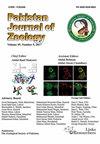Haemato-biochemical Changes and Various Risk Factors Associated with Bovine Coronavirus Infection in Cattle Calves
IF 0.5
4区 生物学
Q4 ZOOLOGY
引用次数: 0
Abstract
Bovine coronavirus (BCoV) is a major viral pathogen linked to respiratory and enteric problems in newborn calves. The goal of this study is to look into the molecular occurrence, haemato-biochemical changes, and risk factors associated with the occurrence of BCoV infection in cattle calves at different dairy farms and small households in the district of Jhelum, Pakistan. From July 2020 to June 2021, 200 faecal samples were collected from newborn cattle calves exhibiting symptoms of diarrhoea and dysentery. S&C Biotech Bovine Coronavirus Antigen Rapid Test Kits were used to screen samples, which were then subjected to RT-PCR for molecular characterization. For the haemato-biochemical analysis, blood was taken from calves infected with BCoV. A questionnaire was used to collect information about the risk factors associated with the occurrence of BCoV infection. BCoV infection was found in 3.5% (7/200) of calves using diagnostic screening kits and 3.0% (6/200) of calves using RT-PCR. Breed, age, sex, vomiting, previous history of diarrhoea, body conditions, food type, colostrum feeding, deworming history, living environment, seasonal variation, and cohabitation with other animals were all assumed risk factors for BCoV infection ( p< 0.05). There was a significant ( p< 0.001) decrease in MCV (fl) and a significant ( p< 0.006) increase in TLC (1x10 3 /cm 3 ) on haematological analysis in BCoV-infected calves. TEC (1x10 6 /cm 3 ), WBC (1x10 6 /cm 3 ), RBC (1x10 6 /cm 3 ), and Hct% were significantly ( p< 0.05) higher. Similarly, infected calves had a non-significant ( p< 0.090) increase in K (mEq/L) and a significant ( p< 0.000) decrease in Na (mEq/L), Ca (mmol/L), Cu (mol/L), and Fe (mol/L) on biochemical analysis. It was concluded that the occurrence of BCoV infection was predisposed by assumed risk factors, and haemato-biochemical alterations were observed in BCoV infected calves.与牛冠状病毒感染相关的小牛血液生化变化和各种危险因素
牛冠状病毒(BCoV)是一种与新生牛犊呼吸道和肠道问题相关的主要病毒性病原体。本研究的目的是研究巴基斯坦Jhelum地区不同奶牛场和小家庭小牛BCoV感染的分子发生、血液生化变化以及与BCoV感染发生相关的危险因素。从2020年7月至2021年6月,从出现腹泻和痢疾症状的新生牛犊身上收集了200份粪便样本。使用S&C Biotech牛冠状病毒抗原快速检测试剂盒筛选样品,然后进行RT-PCR进行分子表征。为了进行血液生化分析,从感染BCoV的小牛身上采集血液。使用问卷收集与BCoV感染发生相关的危险因素信息。使用诊断筛查试剂盒检测到3.5%(7/200)的小牛感染BCoV,使用RT-PCR检测到3.0%(6/200)的小牛感染BCoV。品种、年龄、性别、呕吐、腹泻史、身体状况、食物类型、初乳摄食、驱虫史、生活环境、季节变化、与其他动物同居等均被认为是感染BCoV的危险因素(p< 0.05)。bcov感染犊牛血液学分析MCV (fl)显著(p< 0.001)降低,TLC (1 × 10 3 / cm3)显著(p< 0.006)升高。TEC (1 × 10 6 /cm 3)、WBC (1 × 10 6 /cm 3)、RBC (1 × 10 6 /cm 3)、Hct%显著升高(p< 0.05)。同样,感染犊牛的K (mEq/L)升高不显著(p< 0.090), Na (mEq/L)、Ca (mmol/L)、Cu (mol/L)和Fe (mol/L)降低显著(p< 0.000)。由此得出结论,BCoV感染的发生与假定的危险因素有关,并且在BCoV感染的小牛中观察到血液生化改变。
本文章由计算机程序翻译,如有差异,请以英文原文为准。
求助全文
约1分钟内获得全文
求助全文
来源期刊

Pakistan Journal of Zoology
生物-动物学
CiteScore
1.10
自引率
16.70%
发文量
306
审稿时长
4.5 months
期刊介绍:
Pakistan Journal of Zoology (Pakistan J. Zool.) publishes original articles in English on all aspects of animal life. Generally these articles will be in, or related to one of the following subject areas: Physiology, Cell Biology, Molecular Biology, Genetics, Bioinformatics, Toxicology, Forensic Science, Developmental Biology, Entomology, Parasitology, Microbiology, Biotechnology, Pathology, Palaeontology. Taxonomy, Environmental Biology, Wildlife, Fisheries, Vertebrate and Invertebrate Morphology. Additionally, the journal considers research on health and clinical studies. Short communications are regularly considered, however, uninvited review articles, first records/reports of known species, case reports/studies and survey reports are not published in Pakistan Journal of Zoology.
 求助内容:
求助内容: 应助结果提醒方式:
应助结果提醒方式:


